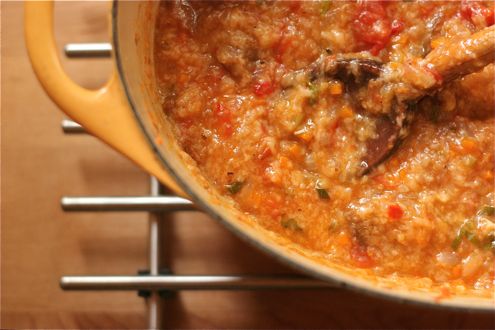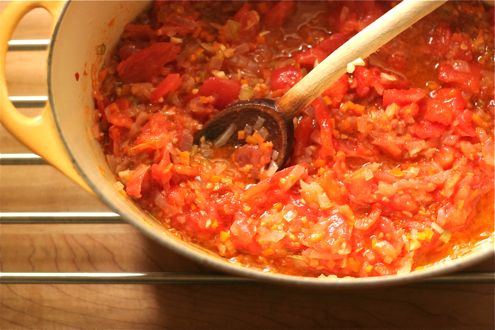 Consider that for years I have scrupulously avoided all dark mineraly leafy greens. Chard, spinach, escarole, kale. So bitter and chewy – not what I was after in a vegetable. So no one could be more surprised than I that my current obsession is with lacinato kale. Dinosaur Kale. Black Kale. The blackest, most tooth-y leafy green of them all. I’m still not quite sure how it happened. And of course kale’s healthy. In fact, as far as I can tell, it’s the healthiest thing at the grocery store. It gets a 1,000 point ANDI* score, right up there with mustard, turnip, collard greens and watercress, making it almost 30% more healthy than even spinach! Why the fixation on kale? The strange dark chewiness – intriguing! I have a girlfriend who is so into lacinato kale that she eats it raw. But first she has to massage the kale. She said it was part of being macrobiotic or something. Massage. Kale. Really?! I should be on the receiving end of any massage, not mere kale.
Consider that for years I have scrupulously avoided all dark mineraly leafy greens. Chard, spinach, escarole, kale. So bitter and chewy – not what I was after in a vegetable. So no one could be more surprised than I that my current obsession is with lacinato kale. Dinosaur Kale. Black Kale. The blackest, most tooth-y leafy green of them all. I’m still not quite sure how it happened. And of course kale’s healthy. In fact, as far as I can tell, it’s the healthiest thing at the grocery store. It gets a 1,000 point ANDI* score, right up there with mustard, turnip, collard greens and watercress, making it almost 30% more healthy than even spinach! Why the fixation on kale? The strange dark chewiness – intriguing! I have a girlfriend who is so into lacinato kale that she eats it raw. But first she has to massage the kale. She said it was part of being macrobiotic or something. Massage. Kale. Really?! I should be on the receiving end of any massage, not mere kale.
Anyway I don’t eat it raw. No. I like kale blanched then sauteed with little rings of shallots and ribbons of prosciutto. Tossed with sherry vinegar and a knob of butter. Or in white bean soup. And make that cannellini beans not navy beans. For me, white bean and kale soup is the pinnacle of all soups. I have been working on variations of this soup for over a year and I think I am nearly there. White bean and kale soup might be a strange thing to crave on a desert island, I know, but for me this is the best kind of food: flavorful, nourishing, and more-ish. So today, I am going to start a two-part article on my desert island food which, shockingly, turns out to be White Bean and Kale Soup with Fennel. The creamy beans, the blackish intensity of the kale, the delicate, particular perfume of fennel. Not to mention the chicken broth holding the whole thing together.
Store-bought stock will not cut it in this recipe. I don’t want you to try this with Pacific Organic Chicken Broth or anything else from the soup section at your grocery store. The full experience starts with a deeply flavorful but light-handed, deftly salted broth. If you start with stock from a box, I can’t be responsible for your impression of my favorite soup! You will think I’m a nutcase if you start with industrial broth. (You probably think I am a nutcase anyway!) We have to start from the beginning. Chicken bones, water, salt and pepper, carrots, celery, etc. And go from there. This is how I do it. Part One.
Chicken Broth
People like Ina Garten start their stock from whole chickens. In Ms. Garten’s case, from 3 whole chickens. I have tried this with 2 whole chickens (my pot, while huge, is not that huge) and it is very nice, but it costs $28 just to buy the birds. Stock should be about thriftiness, though not mean frugality. The components should be fresh and plentiful, but whole chickens?! Not here. Save them for roasting and do as I do. Fresh backs and necks with maybe a leftover roast leg or thigh for richness.
Don’t freak out about the length of the recipe. This is fifteen minutes of hands on work. Fifteen minutes! You can handle it.
- 4 pounds of backs and necks
- if you have them, any frozen roasted chicken bones or leftovers from a roast chicken
- 3 large carrots, peeled and chopped into 1″ pieces
- 3 celery stalks, washed and chopped into 1″ pieces
- 2 red onions, peeled and cut into 8 pieces
- 1 head of garlic cut in half across the equator
- 2 bay leaves
- 24 peppercorns
- parsley, tied up and tied to the pot
- olive oil, sea salt, ground black pepper
Preheat the oven to 450.

Toss the raw chicken backs and necks in a wide roasting pan, giving the bones plenty of space with 2-3 tablespoons of olive oil and 1 heaping tsp of sea salt and some freshly ground black pepper.

Roast for 4o minutes, until deeply browned and very fragrant.
Put the bones in the bottom of your soup pot. I used to use an enormous stainless steel pot, but it was so unwieldy and the process became too much of a production. Now, I use an 8 quart Le Creuset stock pot that I think of as medium sized and make enough stock for 2-3 pots of soup. I use 8 cups of stock for the soup and freeze the leftovers.
Once the bones are in the soup pot, the roasting pan will be a sea of chicken fat and olive oil, pour all of it off and dispose of it properly (not down the drain!). Then take about 1/2 cup of water and scrape up all the brown flavorful bits off the bottom. Do this while the pan is still hot! Be thorough – there is a lot of flavor there. Pour all of the browned pieces and now very flavorful water into the stock pot as well.

Add any leftover roasted bones from a roasting chicken now, or any leftover cooked chicken on the bone if you have it.

Place the carrots, celery, onions, garlic, bay, peppercorns and parsley into the pot. You can tie the parsley to the side, or not. I like to fish the parsley out at the end as it is kind of slimy and soggy – even though I strain the stock anyway.

Add water until it completely covers the chicken and vegetables and is dangerously close to overflowing.
Heat the water over high heat until just about to boil. Then lower the heat and simmer very, very gently (barely bubbling) for 3-4 hours. Skim off any scum that forms on the top.
When the level of the soup has dropped about an inch and your house is redolent with the the warm scent of chicken broth, it is time to taste. Be thoughtful – you haven’t added sea salt yet. You have to think carefully about what you are tasting. And you have to choose, salt the broth now or salt the soup later? I usually salt the soup later – at the beginning when I am cooking the onions, carrots and celery. If you can’t wait that long to start to see that it is perfect already, add one teaspoon of sea salt (I love Redmond Salt from Utah), taste and then add very small increments until your stock tastes lightly salted and totally delicious.
Now it is time to strain off all the vegetables and chicken and bones which will be sapped of anything worthwhile and need to be thrown away. Line a colander with 3 layers of paper towels and ladle the broth through them into a large bowl. You will probably need at least two large bowls.
Then, if you are making soup the next day, ladle 8 cups into a storage container that fits into your refrigerator. Ladle the rest into Ziplock bags in either 4 or 8 cup increments and freeze, labelled and with the date.
I do this every 3 weeks and now I have a huge stockpile of…errr, stock!
*Aggregate Nutrient Density Index http://andiscores.com/
P.S. Ok…after some thought – who am I kidding?! Kale and White Bean Soup may be my desert island food right now – but how long will this obsession really last!?!?! When I change my mind, I’ll let you know.





































